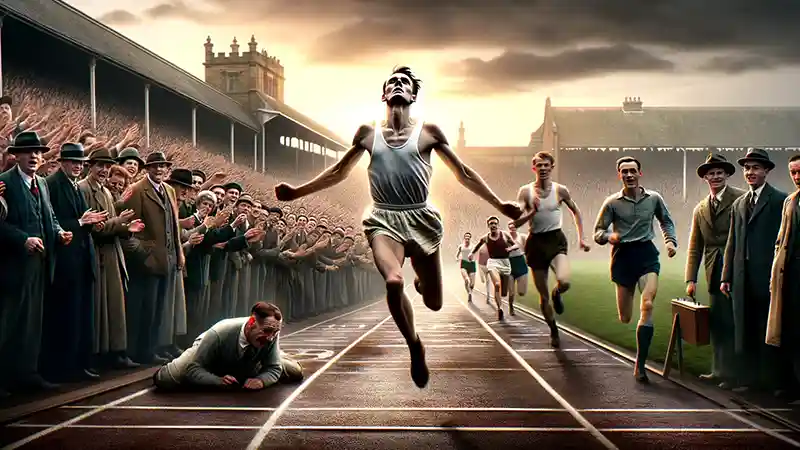Roger Bannister’s story is a testament to the power of determination, resilience, and self-belief. Students are constantly faced with their own “four-minute miles” – challenges that may initially seem insurmountable. These could be academic hurdles, personal goals, or even social barriers.
Bannister’s journey teaches us that with perseverance and belief in ourselves, we can break through the barriers that hold us back. Just as he defied the odds and achieved the impossible, students can overcome the challenges that lie ahead. Whether it’s striving for better grades, building stronger relationships, or pursuing their passions, no goal is too distant, and no obstacle is too great.
Learning Goals
- I will be able to recount the story of Roger Bannister and the significance of his achievement.
- I will be able to analyze how challenges can be transformed into opportunities for growth and achievement.
- I will be able to reflect on personal experiences of overcoming challenges and apply lessons learned from Bannister’s story.
- I will be able to discuss the importance of perseverance, support, and belief in oneself in achieving seemingly impossible goals.
Materials
Breaking the Barrier: The Roger Bannister Story
In a time not too long ago, the idea that a human being could run a mile in under four minutes was considered sheer fantasy. Picture a world brimming with skepticism, where the collective wisdom of scientists, doctors, and even the most elite athletes concluded that such a feat was beyond the realm of human ability. They argued that our bodies were not built for such speed, that our hearts, lungs, and muscles would give out before crossing the finish line. This wasn’t just a theoretical limit; it was seen as a concrete wall in the path of human physical achievement.
Enter Roger Bannister, a young, determined medical student from the heart of England. Unlike his contemporaries, Bannister was not deterred by the naysayers or the scientific consensus of his time. He saw the four-minute mile as a challenge to be overcome. Armed with a fierce intellect and an unbreakable spirit, Bannister approached the problem with the eye of a scientist and the heart of a champion. He carefully analyzed every aspect of running, from the way the human body worked to the psychology of endurance
Early Life and Challenges:
Roger Bannister, born in the year 1929 in the quaint town of Harrow, England, embarked on his journey in his school playground. This unconventional beginning did not deter him; rather, it fueled his passion for running. Early on, Bannister’s races were not against competitors. He raced against his own best time. These solitary challenges laid the foundation for his resilience and determination. Unlike many of his contemporaries who enjoyed the luxury of fancy training facilities and specialized coaching, Bannister’s initial push into the world of athletics was marked by simplicity and self-motivation. His talent for running was evident from a young age, but it was his unwavering spirit that truly set him apart.
Balancing academic pursuit with athletic ambition is a difficult task for anyone, but for Bannister, it was a challenge he accepted with grace. As he ventured deeper into the realms of medicine, his commitment to his studies never detracted from his passion for running. Instead, he managed to combine these aspects of his life, allowing the academics to improve his athleticism. Despite the obstacles that stood in his way, Bannister’s dedication to both his medical studies and his running career never faltered.
The Goal:
While studying at Oxford University, Bannister set himself an impressive goal: to break the four-minute mile, a feat that was considered impossible at the time. He wasn’t the only one aiming for this record, but what set Bannister apart was his approach. He balanced his training with his demanding medical studies. Furthermore, he used what he learned to scientifically improve his performance.
The Struggle:
Bannister faced setbacks and disappointments along the way, including missing out on a medal at the 1952 Olympics. This defeat could have crushed his spirit, but instead, it fueled his determination. He analyzed his training and racing strategies, making adjustments where needed. Bannister’s journey was a mental battle against doubt: both his own and others’.
The Breakthrough:
On a memorable day, May 6, 1954, in Oxford, England, a remarkable event took place on a track that would go down in history. Roger Bannister, with determination in his heart and the support of his friends Chris Brasher and Chris Chataway, embarked on a journey to break a record many thought impossible. As Brasher and Chataway set the pace, Bannister endured not just the physical challenge of running, but also the heavy burden of doubt that had accumulated over the years. Everyone watching held their breath as Bannister sprinted toward the finish line, his every step a testament to human endurance and spirit.
As Bannister crossed the finish line, a moment of pure exhilaration unfolded. The announcer’s voice, trembling with excitement, began to declare the time, “Three minutes…” but before he could even finish, the crowd’s cheers drowned out his words. They didn’t need to hear the rest; they knew history had been made. Bannister had achieved the unthinkable – a mile in 3 minutes and 59.4 seconds. This wasn’t just a victory for Bannister; it was a triumph that showed the world the power of perseverance and belief in oneself.
Aftermath and Legacy:
Bannister’s achievement was more than just a new record; it was a testament to human potential. His feat showed the world that barriers exist to be broken. Inspired by his groundbreaking run, athletes around the globe have since shattered his record multiple times, proving that it only takes one person’s success to light the spark in others, encouraging them to believe in their own capabilities and to push beyond their limits. This ripple effect of inspiration underscores the idea that once a seemingly insurmountable barrier is broken, it opens the door for others to surpass it, turning the impossible into the next target for aspiring champions.
Following this monumental achievement, Bannister continued his journey, not on the track, but by pursuing an equally challenging and rewarding career as a distinguished neurologist. His life serves as a powerful reminder that with dedication and hard work, it’s possible to achieve excellence in multiple fields. Bannister embodied the ideal that success is not confined to a single aspect of our lives but is achievable in any area we choose to dedicate ourselves to, encouraging young minds to explore and excel in diverse interests and passions.
Reflection and Questions
Answer at least three questions below:
- Roger Bannister saw the four-minute mile as a challenge rather than an impossibility. Can you think of a time when you faced a challenge that seemed impossible at first? How did you approach it, and what was the outcome?
- Bannister balanced his academic pursuits in medicine with his athletic training. How do you balance your schoolwork with your hobbies or sports? What strategies help you manage your time effectively?
- Despite not having access to fancy training facilities or specialized coaching, Bannister’s passion and self-motivation led him to greatness. How can you apply self-motivation in your own goals, even when resources are limited?
- After facing disappointment at the 1952 Olympics, Bannister didn’t give up but instead used it as fuel to push harder. Share a time when a setback or failure motivated you to try harder. What did you learn from that experience?
- Bannister’s breakthrough moment was when he broke the four-minute mile, a feat many thought was impossible. Have you ever achieved something that you or others thought was unattainable? How did it make you feel?
- The story mentions Bannister’s “unbreakable spirit” and “fierce intellect.” Which of these qualities do you see in yourself, and how do you or could you use them to achieve your goals?
- Bannister’s success had a ripple effect, inspiring others to break his record. Who inspires you to push beyond your limits, and how can you be an inspiration to others?
- Bannister continued to achieve excellence in his career as a neurologist after his athletic accomplishments. Why do you think it’s important to pursue multiple interests or passions in life?
- The announcer’s excitement and the crowd’s cheers at Bannister’s record-breaking run highlight the impact of support from others. How does support from friends, family, or mentors help you in achieving your goals?
- Reflecting on Bannister’s legacy, he proved that “barriers exist to be broken.” What is one barrier or goal you hope to overcome or achieve in the future, and what steps will you take to reach it?


